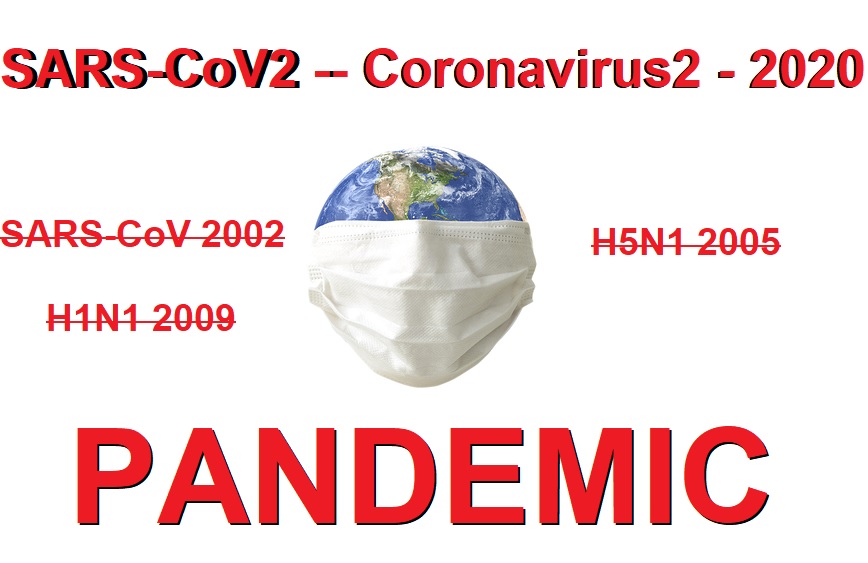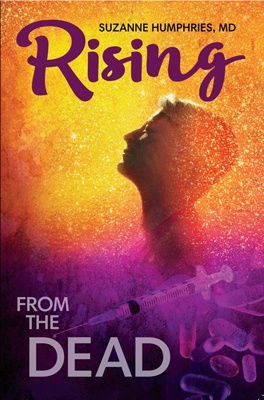
Coronavirus Pt 1: How Soon We Forget – Same Playbook, Different Virus
by Dr. Sherri Tenpenny, AOBNM. ABIHM
VAXXTER
I have been sitting back, listening to and watching the crushing plan “they” have designed for us. I have been viewing this fiasco through the lens of history.
I wrote this article to give you some perspective. I couldn’t help but think when this COVID19 blitz started, “How soon we forget…”
Over the last three weeks, unless you have been cloistered in a monastery in Tibet, you have been bombarded with at least 2.1 billion media mentions regarding a new form of coronavirus that has spread rapidly around the world. As a comparison, when Ebola was in the news last year, it received a mere 16.3 million media mentions.
The world economy has ground to a stop over the pandemic spread of coronavirus SARS-CoV2, the proper name for the virus. This name was chosen because the virus is genetically related to the coronavirus responsible for the SARS outbreak of 2003. Coronavirus disease 2019, or COVID-19, is the illness caused by the SARS-CoV2 virus. The two terms are used interchangeably but the words are not synonyms.
According to the CDC, coronaviruses are named for the crown-like spikes on their surface. There are 36 coronaviruses in the family Coronaviridae. The viruses are known to cause respiratory or intestinal infections in humans and some animals.
These common, mostly benign respiratory viruses were first identified in humans in the mid-1960s.
The coronaviruses that commonly infect people are:
- 229E (alpha coronavirus)
- NL63 (alpha coronavirus)
- OC43 (beta coronavirus)
- HKU1 (beta coronavirus)
These four common human viruses cause 10–20% of respiratory infections worldwide and are present on all continents. Most likely, you have been exposed to, and perhaps ill from, a coronavirus infection at some point in your life and may have some level of natural immunity to this virus.
Round #1, 2002: SARS – Coronavirus
The first reported case of the “mysterious flu” was reported in November 2002. Scientists went into high gear and found the pathogen to be a highly pathogenic coronavirus originating in the Guangdong province in China.
Experts were concerned because it had never previously been seen in humans. Named SARS-CoV, for “severe acute respiratory syndrome caused by a coronavirus,” its spread set off panicked alerts across the globe. The WHO issued its first global alerts in early March 2003, even though the majority of cases were limited to the Chinese province.
Ten years later a similar, highly pathogenic coronavirus called the Middle East respiratory syndrome coronavirus (MERS-CoV) would emerge in Middle Eastern countries leading to severe respiratory distress syndrome in humans.
Teams of experts were sent to investigate the SARS outbreak. The hysteria ramped up quickly and within weeks, the Hong Kong Department of Health issued an unprecedented quarantine order, keeping residents inside their homes.
Shortly thereafter, Mainland China followed suit, closing public schools, cinemas, and libraries in an attempt to stop the spread of the virus. As more cases began to be reported in Toronto, Canadian health officials warned residents to quarantine themselves, wear masks, and in some cases, just stay home.
Over the six month duration of the pandemic, 8,049 people tested positive for the virus. The vast majority of cases occurred in China, Hong Kong, and Taiwan, with a resulting 774 deaths, or close to 10% of known cases.
But since the total number of cases only represented those ill enough to seek medical help, the actual death rate is unknown and may have been far less.
In spite of the fact that few people in Canada were affected (251) and even fewer died (43), the Canadian Tourism Board estimated that the SARS epidemic cost the nation’s economy $419 million.
The Ontario health minister reported that the cost to the province’s health-care system, including money spent to develop special clinics and stock them with supplies to protect healthcare workers, was nearly $763 million.
SARS had a significant effect on the airline industry. Singapore Airlines lost $6 million each day during April and May when SARS choked off intra- and inter-Asian travel. Other less obvious industries that suffered during the outbreak were retail sales, hotels, and restaurants.
When translated into an absolute dollar amount, these figures imply that the global economic loss from SARS was close to $US40 billion in 2003. This figure is much greater than the medical costs of treating SARS patients.
Is this sounding familiar?
As SARS-CoV faded into obscurity in 2004, and has never been seen again, a new pandemic was coming to the forefront. But this time, it was an influenza virus, H5N1, that was gaining the attention of the WHO and the mainstream media.
Influenza viruses are identified as three distinct immunogenic types—A, B, and C—and a large number of subtypes. Type C viruses are associated with either assymptomatic or very mild respiratory illness and do not carry with them a public health impact. Influenza type B infections also tend to cause minor illnesses. Having a propensity for older persons, influenza type B viruses are most often identified in nursing home outbreaks. Influenza types C and B have only been identified in humans. Until the emergence of the H5N1virus, the only influenza A viruses associated with humans since 1977 have been H1N1, H1N2, and H3N2.
Influenza A subtypes have been designated as either mildly pathogenic, meaning they cause minimal or no disease, or highly pathogenic, meaning their presence has been associated with widespread infection.
Since the 1980s, all outbreaks of highly pathogenic influenza has been caused by antigen subtypes H5, H7, and H9.
Round #2, 2005: Bird Flu, H5N1
A pandemic by definition is an outbreak of an infection occurring over a very wide area, crossing international boundaries and usually affects a large number of people. By those standards, the bird flu exploded onto the world stage in May 1997 through an ironically innocent setting.
A Hong Kong pre-school had set up a small petting zoo on its grounds, making a home for five chickens and eight ducks. The children were delighted to spend time with their feathered friends.
Several days after the school aviary experience, a three-year-old boy began to cough. The illness and fever progressed rapidly, and the boy’s parents rushed him to Victoria Hospital where he was admitted with pneumonia and respiratory distress. Six days later, he died.
Pathologists found no underlying immunodeficiency or cardiopulmonary disease that would have contributed to the boy’s death. Three months later, the virus was confirmed to be avian influenza A virus with surface antigens H5N1. In a report published later, researchers held that this particular bird flu virus had not previously caused infection in humans.
Teams from the WHO and the CDC descended on Hong Kong to determine how the boy had been exposed to the bird flu virus and to assess the potential public health impact.
According to investigators, one of the chickens in the petting zoo had died several days before the child’s symptoms had appeared. It was postulated that the boy had been exposed to the ill bird, meaning, the virus had “jumped species” and had infected the boy.
In the following days and weeks, officials scrambled to determine if the virus had infected those who had been exposed to the ill child. Approximately 2,000 human samples were collected from those who had been in contact with the boy, the school’s petting zoo, or the birds from the rural areas; no additional cases were identified.
Then, a second case of H5N1 infection was confirmed in a person Hong Kong, and 18 more cases appeared over the following months. With news of the direct bird-to-human transmission, the CDC and WHO believed the next pandemic had arrived.
Again, is this sounding familiar?
Throughout the evolving epidemic, China denied the presence of bird flu in chickens or humans.
However, that changed in 2005 when China reported 7 human cases with three deaths to the WHO. All across the expansive country, millions of farmers were living in close proximity to billions of chickens, the reservoir of the H5N1 virus.
Reporting only seven H5N1 human infections seemed extraordinarily low. Many virologists around the world have questioned the relative absence of human cases, given there had been 30 highly pathogenic viral outbreaks in poultry across ten provinces throughout 2005.
China lied twice before; is there any doubt they could very well be lying now?
Round #3, 2009: Swine flu (H1N1)
In the spring of 2009, another pandemic siren shrieked across the US and around the world. This time, it was over a novel strain of influenza A.
When the origin of the virus was found to be in pigs from a small region in central Mexico, the outbreak became known as “swine flu” and the viral nomenclature was H1N1.
The WHO quickly declared a “public health emergency of international concern.” By June, the WHO and the CDC stopped counting cases and declared the outbreak swine flu to be a pandemic.
About that same time, experts around the world were saying that this H1N1 swine flu virus was not aggressive enough to cause a worldwide pandemic, noting that the mortality rate among confirmed cases was 1.6% in Mexico and only 0.1% in the United States.
At press conferences, various medical experts made remarks such as, “It is unclear if we need to use vaccines against the swine flu because the virus does not have a pandemic nature,” and “Does the world really need a vaccine for an illness that so far appears mild?”
Nonetheless, loaded with government funds, the Big Boys in vaccine manufacturing plowed ahead.
By September, Pandemrix, made by GlaxoSmithKline (GSK), Focetria, made by Novartis and Arepanrix,a vaccine similar to Pandemrix and also made by GSK, was approved for use the following month. Celvapan, a whole virus vaccine made by Baxter was approved but soon withdrawn from market because it caused extremely high fevers.
All of these vaccines were fast-tracked to market with no long term studies and very few test subjects in the trials. Let’s take a look at the ingredients*:
- Pandemerix:
- Adjuvant: AS03 which contains squalene (10.69 mg), polysorbate 80 (4.86 mg) and alpha-tocopherol (11.86 mg)
- Other ingredients: egg proteins, polysorbate 80, octoxynol 10, thimerosal (mercury), sodium chloride, disodium hydrogen phosphate, potassium dihydrogen phosphate, potassium chloride, magnesium chloride, water for injections.
- Focetia:
- Adjuvant: MF59 which contains squalene (9.75 mg), polysorbate 80 (1.175 mg) and sorbitan trioleate (1.175 mg)
- Other Ingredients: egg proteins, thimerosal (multidose vial only), sodium chloride, potassium chloride, potassium dihydrogen phosphate, disodium phosphate dihydrate, magnesium chloride hexahydrate, calcium chloride dihydrate, sodium citrate, citric acid and water for injections. [what do all those chemicals do to human cells?]
- Arepanrix
- Adjuvant: AS03 which contains squalene (10.69 mg), polysorbate 80 (4.86 mg), NS alpha-tocopherol (11.86 mg)
- Other Ingredients: egg proteins, thimerosal, formaldehyde, sodium deoxycholate, sucrose, sodium chloride, disodium hydrogen phosphate, potassium dihydrogen phosphate, potassium chloride, water for injections.
*For a detailed discussion regarding vaccine ingredients, see www.VaccineU.com and the 7-part course on Problematic Ingredients.
The pandemic vaccines were very problematic. In fact, Pandemerix was later shown to conclusively be associated with narcolepsy.
More than 1300 people who received a vaccine to prevent the flu developed narcolepsy, an incurable, debilitating condition that causes overpowering daytime sleepiness, sometimes accompanied by sudden muscle weakness in response to strong emotions such as laughter or anger. Worse, the vaccines did little to lower the death rate.
The pandemic began to taper off in November 2009, and by August 10, 2010, the Director-General of the WHO, Margaret Chan, announced the end of the H1N1 pandemic. The CDC estimates that between April 12, 2009 to April 10, 2010, there were 60.8 million people infected, with 274,000 hospitalizations, and 12,469 deaths – a mortality rate of 0.02% due to the virus.
Again, is this sounding familiar? Millions infected; low mortality rate. No economic cataclysmic events, no “social distancing”, no masks, no community lock downs.
Round #4, 2020: SARS-CoV2 – Coronavirus2
A third, highly pathogenic virus emerged out of Wuhan, China in December 2019. SARS-CoV2, the novel coronavirus, has rapidly spread across the globe and as of this writing, has affected more than 90,000 people worldwide.
Although China launched an early emergency response, the infection rapidly spread. In early January 2020, a total of 24 days after the index COVID-19 case in Wuhan, a family traveled from Wuhan Shenzhen, spreading the virus to that city. Subsequently, more cases were reported. From there, the virus seemed to transit the world.
Researchers were analyzing the data being accumulated from lab tests, nasal swabs, and stool samples. What they found was that common coronaviruses were the predominant strain identified, most likely due to their global distribution and their non-negligible mortality. This full-text article, from the International Journal of Antimicrobial Agents, reports:
- As of 2 March 2020, 90,307 patients had tested positive for SARS-CoV-2 worldwide, with 3086 deaths (mortality rate 3.4%).
- As of 2 March 2020, among OECD countries, 7476 patients had tested positive for SARS-CoV-2, with 96 deaths (mortality rate 1.3%)
- As of 2 March 2020, in France, 191 people had tested positive for SARS-CoV-2, with three deaths (mortality rate 1.6%).
- Between 1 January 2020 and 2 March 2020, 7,059 samples were positive for coronaviruses with two deaths. There were no cases of SARS-CoV-2 identified. The deaths were associated with strain OC43 and the other with strain HKU1. Underlying co-morbidities were not lists.
- “This mortality rate of SARS-CoV2 In European or American developed countries of a comparable economic level the SARS-CoV2 mortality rate is 1.3%. This is not significantly different from that for common coronaviruses identified in the study hospital in France. (mortality rate 0.8%; p=0.11)
- “In fact, mortality from respiratory infections is extremely dependent on the quality of care and access to care, and severe forms have better prognosis in countries with superior medical infrastructures.”
- “Therefore, in OECD countries, SARS-CoV-2 does not seem to be deadlier than other circulating viruses.”
I hope that this historical discussion puts SARS-CoV2 and COVID19 into perspective. We are watching the same hysteria, the same fear-mongering, the same low death rates.
And this time, we may even have a medication, hydroxychloroquine, that eliminates the severe symptoms quickly. Get involved in preserving your right to refuse…because the vaccine is coming, even if the medications work.
In Coronovirus Part 2 – I’ll be discussing my perspective on why so many elderly died in Northern Italy.
Read the full article at Vaxxter.com. Republished with permission.
About the Author
Dr. Sherri Tenpenny is an osteopathic medical doctor, board-certified in three specialties. She is the founder of Tenpenny Integrative Medical Center, a medical clinic located near Cleveland, Ohio. Her company, Courses4Mastery.com provides online education and training regarding all aspects of vaccines and the vacce
Dr. Tenpenny has invested nearly 20 years and more than 40,000 hours documenting and exposing the problems associated with vaccines. As an internationally known speaker and author, her many articles have been translated into at least 15 languages. She is a frequent guest on radio and TV to share her knowledge and educate parents on why they should Just.Say.No. to vaccines.
Leaving a lucrative career as a nephrologist (kidney doctor), Dr. Suzanne Humphries is now free to actually help cure people.
In this autobiography she explains why good doctors are constrained within the current corrupt medical system from practicing real, ethical medicine.
One of the sane voices when it comes to examining the science behind modern-day vaccines, no pro-vaccine extremist doctors have ever dared to debate her in public.
-
Book – The Vaccine Court, by Wayne Rohde – 240 pages
“The Dark Truth of America’s Vaccine Injury Compensation Program”
FREE Shipping Available!
ORDER HERE!








Leave a Reply